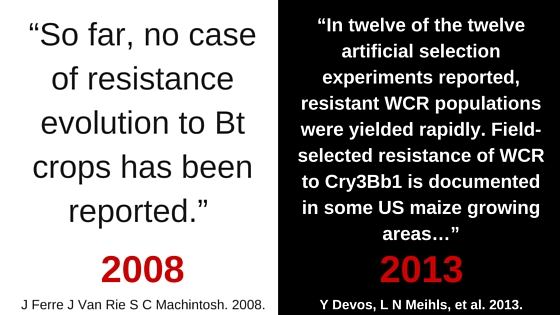Bacillus thuringiensis is a bacteria that can produce a toxin. A gene for this toxin is Cry1Ac. The Bt or Cry1Ac toxin kills insects by cutting up their digestive system. Cry1Ac toxin does not have effects on non-insects. We’ll use this table to rate the GMO.
Monsanto first inserted the Cry1Ac gene into cotton (Monsanto, 2002). The Bt Cotton has reduced the use of pesticides. Because of the need for fewer pesticides, fewer farmers report pesticide poisoning. Farmers spend less money on pesticides. Consumers don’t see any price difference. (Pray, Ma, Huang, and Qiao, 2001)
Bt Cotton has also shown to increase yields for farmers in poorer countries (Thirtle, Beyers, Ismael, and Piesse, 2003)
Let’s look at the current rating. 0 for the direct effect on humans. +1 for indirect effects on human health.+1 on profit for local producers. 0 for the profit of consumers. -1 on planet biodiversity. The only measurement left is planet habitat. To see this we need to look at the long term effects.
Why look long term? There is a common question for GMOs and biotechnology. What are the long-term effects? Just looking at one year a system might work, but over several years a system might fail. With just one years worth of data you would conclude an opposite result than a multi-year study.
One long term effect is resistance of insects to Bt toxin. Insects eat the plant. The plant produces Bt toxin. The insect eats the Bt toxin. The insect dies. This systems might work however life always finds a way. The insects become resistant to the toxin.
There are two reasons why insects develop resistance to the Bt toxin. One reason is that it is only one compound. If there were many compounds all affecting different parts of the insect it would take longer for the insect to adapt to all of the compounds. The second reason is that the compound kills the insect. Death is the strongest selective pressure in evolution. If an organism dies before mating then all genetic information is gone. If the GMO instead had a compound that disabled the insect instead of killing it would take longer for the insect to adapt.
Compounds that disable but not kill the pest are found in nature. These compounds could be used instead of Bt toxin to prevent insects from becoming resistant.
The first generation of Bt toxin plants produce the toxin throughout the plant, possibly effecting beneficial insects like pollinators. This is reducing the habitat available for insects. Overall this GMO would get a score of 0. Good at reducing run-off and preventing insect damage, bad a increasing biodiversity and habitat.
Did you learn something? Did we get something wrong? Leave a comment below.
Work Cited:
Monsanto. 2002. Safety Assessment of Bollgard Cotton Event 531. http://www.monsanto.com/products/documents/safety-summaries/bollgard_pss.pdf
Pray, C., Ma, D., Huang, J., & Qiao, F. (2001). Impact of Bt cotton in China.World development, 29(5), 813-825.
Thirtle, C., Beyers, L., Ismael, Y., & Piesse, J. (2003). Can GM-technologies help the poor? The impact of Bt cotton in Makhathini Flats, KwaZulu-Natal.World development, 31(4), 717-732.
Ferre, J., Van Rie, J., Machintosh, S. C., (2008). Insecticidal Genetically Modified Crops and Insect Resistance Management (IRM). Progress in Biological Control. 5, 41-85
Devos, Y., Meihls, L. N., et al. (2013). Resistance evolution to the first generation of genetically modified Diabrotica-active Bt-maize events by western corn rootworm: management and monitoring considerations. Transgenic Research. 22(2), 269-299



